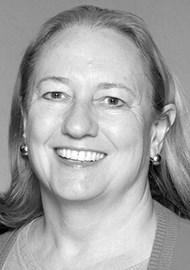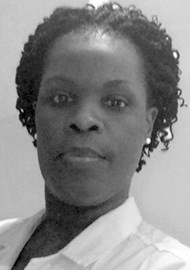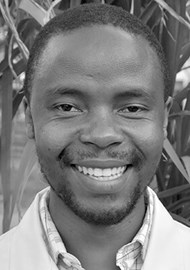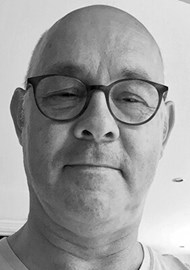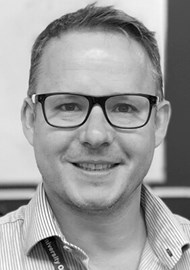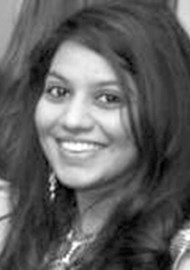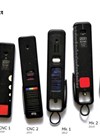There has been a VISION 2020 LINK between Mulago Hospital and Makerere University in Kampala, Uganda and the Royal Free Hospital, London, since 2010. There have been regular training visits between teams from the eye departments at Mulago and the Royal Free over the last nine years, focusing on capacity-building and enhancing skills of eye health professionals, with the goal of helping to improve the quality and quantity of service delivery.
The LINK is mutually beneficial, with Royal Free participants benefiting from enhanced teaching skills, increased motivation, better multidisciplinary team working and experience of late presentation of conditions such as retinoblastoma.

People waiting to be examined at a community eye clinic in Uganda (photo Terry Cooper).
The Ugandan Fourth National Eye Health Plan, 2016-2020, identified the need to focus on prevention and community eye screening to access hard-to-reach communities. The community clinics project reported here was developed in line with this and the World Health Organization (WHO) global action plan – Universal Eye Health [1]. The vision of the WHO global action plan is a world in which nobody is needlessly visually impaired, where those with unavoidable vision loss can achieve their full potential, and where there is universal access to comprehensive eye care services.
Within Uganda there is a second VISION 2020 LINK, between Mbarara University of Science and Technology (MUST) and Bristol Eye Hospital. For this project, input was needed from both LINKS in order to pilot community eye clinics in different parts of Uganda. The two LINKS had already been brought together under the auspices of the Diabetic Retinopathy Network (DR-NET) [2], which seeks to reduce unnecessary blindness due to DR in low- and middle-income countries (LMICs).
“Had it not been for the free eye camp, I could not have afforded a pair of spectacles as they are too expensive for me to buy here. Now I am able to see again”
Patient at the Buwenge community clinic
Community eye clinics are one way of identifying people living with diabetes, particularly as those who live in remote villages are often undiagnosed. This project addressed the need for increased community access with training in identification of DR and other eye conditions, as well as bringing together the two VISION 2020 LINKS in Uganda.
Project goal
The goal was to increase access to eye healthcare in Uganda by establishing and implementing a programme to train eye health workers in setting up and running community clinics, with emphasis on detection of DR.
Objectives
The objectives of the community outreach project were:
- To train eye care professionals to provide outreach services to patients in ‘hard to reach’ communities.
- To collect data on ophthalmic diagnoses and prevalence of diabetes and DR in adults in these communities.
The funding for the project came from two sources – a one-year project grant from the Tropical Health Education Trust (THET) [3], which awards and manages funds for health partnerships from the Department for International Development. It was also funded in part by the Queen Elizabeth Diamond Jubilee Trust, which has been funding DR-NET activities through a five-year grant since 2014 [4]. The authors are very grateful to the funders for enabling this project to take place.

A community eye clinic underway inside a church (photo Terry Cooper).
Training workshops
A team from the Royal Free Hospital visited Uganda in March 2018 and ran two-day workshops in three places – Kampala, Jinja and Mbarara. A total of 90 eye health workers attended the three training workshops.
Participating eye care workers learnt how to use an Icare tonometer (Icare Finland) [5] to measure intraocular pressure, an Arclight ophthalmoscope (Arclight Medical, Liverpool, UK) for examination of the eye [6] and a RetinaLyze portable fundus camera (Hellerup, Denmark) to take images of the fundus [7], in order to assist in the diagnosis and management of patients. Training in capturing and storing data in the challenging setting of an outreach clinic was included in the workshops.
Workshops and clinical activity addressed the following issues identified as barriers that prevent access to eye healthcare in LMICs:
- Awareness: workshops covered methods to increase awareness of the importance of regular eye checks.
- Cost: workshops covered how to reduce costs to patients by effective clinic location planning.
- Distance: running clinics close to patients to reduce logistical problems for patients in getting to a clinic.
- Fear: carrying out clinics in familiar surroundings such as churches and community centres to help alleviate fear.
Towards the end of the two days, the participants started to plan future outreach clinics, with specific roles assigned to each member of the team. In addition, a subgroup of eye care workers in each location were also taught to train new eye care workers how to organise clinics, mobilise patients, collect data, use ophthalmic equipment and to diagnose the commonly-presenting eye conditions. These were taught by the ‘Train the Trainers’ method (TTT) to enable the skills to be cascaded.

Results
1. Diagnostic equipment training
Icare
The Icare tonometer used for measuring intraocular pressure was easy to use, repeatable and robust. We concluded that this was a suitable instrument for outreach clinics for use by non-ophthalmologists. The two that were bought on the project were donated to MUST and Mulago Hospitals.
Arclight
The Arclight proved to be easy to use by non-ophthalmologists and useful for anterior segment and direct ophthalmoscopy, where the pupils are dilated and media clear, and where the ambient light is not too bright. It is possible to cover the ophthalmologist and the patient with a lightproof cover. Fifty Arclights were donated to the project by Arclight Medical.
RetinaLyze
The RetinaLyze fundus cameras with automated software for screening of images were more difficult to use and were less suitable for use by eye care workers who were not familiar with using them regularly. There were difficulties using them where the pupil was not well dilated, or if there were media opacities. Of the 60 patients with diabetes, where fundus examination is important, four patients with sight-threatening diabetic retinopathy were identified and referred for treatment. In that population, six (10%) would have been expected, but the numbers are too small for any conclusions as to the usefulness of the camera to be drawn from this result. The fundus cameras are potentially useful in the outreach setting because they are portable, as long as they are in the hands of people familiar with their use. After the project, the two RetinaLyze cameras bought with project funds were donated to Mulago Hospital and the diabetic eye screening and treatment programme in Mbarara.

2. Planning and delivering community outreach clinics
After the training offered by the three workshops, a series of community clinics were planned and carried out so that participants had a chance to put their learning into practice. Community outreach clinics took place in seven locations in June and September 2018 (Table 2). All but one were held in remote rural areas; the last clinic was in Mbarara, which is the largest town in Uganda besides the capital, Kampala. All seven clinics lasted for one day each. Each clinic was publicised with a ‘mobilisation plan’ using posters and radio announcements organised by the local partners.
One of the training activities at the workshops had been how to deliver a patient education talk. During the clinics, ophthalmic nurses and ophthalmic clinical officers (OCOs) delivered talks on the importance of getting an eye exam, with the request to patients to tell all their family members and friends about this when they returned home from the outreach clinic.

The teams from Mbarara and the Royal Free Hospital (photo Terry Cooper).
3. Clinical findings
In total 1110 patients were examined during the seven one-day outreach clinics. Of these, 100 in need of cataract surgery were referred to the nearest hospital. Twelve people previously undiagnosed had diabetes detected and were referred; 17 people previously undiagnosed had glaucoma detected and were referred to hospital (in all cases with prior permission from the hospital). Three hundred and forty-seven people were given glasses for presbyopia.
There was a big difference in the numbers of people with diabetes between the districts. In Lira and around Jinja the rates were similar (very low in these rural areas); the body mass index (BMI) was also low. In Bugamba, prior to the outreach clinic being held, people were asked to come to the clinic if they had diabetes and this probably explains the higher proportion of people living with diabetes (PLWD) seen. In our experience there was more diabetes and a higher BMI in the west of Uganda, specifically the Mbarara city area, than in the rural east and north of the country.
Conclusions
This project was a novel way of developing skills and awareness of eye health workers in Uganda in ways of increasing access for hard-to-reach patients by planning and delivering community eye clinics. From the perspective of patients living in hard-to-reach communities, particularly in rural areas, the project has had a significant impact. There are now many more eye care workers in Uganda who are able both to set up and carry out community eye clinics, and to diagnose eye problems in a challenging setting.
Since our last visit, the team in Mbarara has cascaded the training to further eye care workers across their region and locally-led community eye clinics with emphasis on DR started in early 2019 and are continuing. The LINK partnerships continue too: in March this year the DR programme lead from Mbarara has spent time in the UK observing at the Royal Free and at community clinics in Worcester, through the DR-NET.
“The community clinic project came at the right time for us because we were about to roll out a community screening project for diabetic retinopathy but we were not quite sure how to do it. The community clinic project gave us training and an opportunity to pilot this in the community. There was a lot of learning on areas of mobilisation, crowd control, managing expectations, linkages with partners and other stakeholders and the very important aspect of data capture and usage. We have since cascaded similar training to all the 17 districts in SW Uganda and since January 2019 have screened about 2200 patients.”
Simon Arunga, Consultant Ophthalmologist, Mbarara University of Science and Technology.
“The outreach workshops came in very handy at a point when the focus is on diabetes. We now know how we can reach our communities and screen them for diabetes and diabetic retinopathy cost-effectively. Our laser, which was refurbished with help from the LINK, enables us to treat the patients.”
Grace Ssali, Consultant Ophthalmologist, Mulago Hospital, Kampala.
“I have learnt how to successfully hold a community eye clinic, learnt about different eye diseases and what causes them. I came to know that elimination of blindness does not necessarily require a specialist eye health worker, as everybody has a role to play.”
Sebastian Waiswa, Community Health Worker, Jinja.
References
1. Universal Eye Health: A global action plan 2014-2019:
https://www.who.int/
blindness/AP2014_19_English.pdf
2. Astbury N, Burgess P, Foster A, et al. Tackling diabetic retinopathy globally through the VISION 2020 LINKS Diabetic Retinopathy Network. Eye News 2017;23(5):30-4.
3. Tropical Health Education Trust (THET):
https://www.thet.org
4. The Queen Elizabeth Diamond Jubilee Trust:
https://www.jubileetribute.org
5. Icare tonometer:
https://www.icaretonometer.com
6. Arclight Medical:
http://arclightscope.com
7. Retinalyze:
https://www.retinalyze.com
(All links accessed May 2019)
COMMENTS ARE WELCOME


